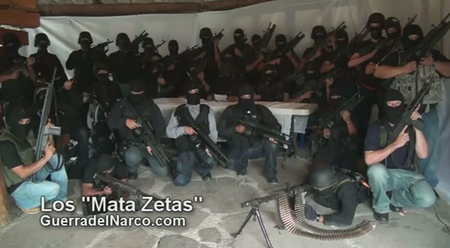There is some disagreement in Mexico as to whether the state and civil society are  engaged in a tough battle (winning or losing, intelligent or short-sighted) against organized crime, or whether organized crime has so permeated the institutions of the state and civil society that it is no longer a separate entity. The emergence, in the state of Veracruz, of a group called the Mata Zetas (Zeta Killers) that has sworn to rid Mexico of its most brutal criminal predators—the Zetas—but which, itself, has strong and acknowledged links to rival criminal groups has brought this argument to a head. The Mata Zetas have declared allegiance to the Mexican state and to the governor of Veracruz, Javier Duarte. They have declared solidarity with the Mexican people. They have attempted to present themselves (convincingly to some, less so to others) as informal members of the state apparatus, carrying out tasks that the formal state cannot undertake.
engaged in a tough battle (winning or losing, intelligent or short-sighted) against organized crime, or whether organized crime has so permeated the institutions of the state and civil society that it is no longer a separate entity. The emergence, in the state of Veracruz, of a group called the Mata Zetas (Zeta Killers) that has sworn to rid Mexico of its most brutal criminal predators—the Zetas—but which, itself, has strong and acknowledged links to rival criminal groups has brought this argument to a head. The Mata Zetas have declared allegiance to the Mexican state and to the governor of Veracruz, Javier Duarte. They have declared solidarity with the Mexican people. They have attempted to present themselves (convincingly to some, less so to others) as informal members of the state apparatus, carrying out tasks that the formal state cannot undertake.
Writing in the weekly magazine Proceso this week, Javier Sicilia, the pacifist founder of the Movement for Peace with Justice and Dignity commented that one of his colleagues had used an image that went right to the heart of the current Mexican reality. The image was mud: the mix of water and earth created by rain. The analogy, wrote Sicilia, was exact: the violence, which had not stopped raining on Mexico since President Felipe Calderón unleashed his drug war five years ago, has generated so much mud that the boundaries between the state and the criminals have been muddied over. What is left, he wrote, is a violence that threatens to reach a point of no return; violence for its own sake; violence that seems to have forgotten what the disputes are all about.
Perhaps it is this fear that animates the debate over whether the Mata Zetas are genuine paramilitaries. The government of Felipe Calderón says no: they are just another criminal group, totally divorced from the struggles for state power. Calling them paramilitaries would acknowledge the haziness of the boundaries between state and criminality, and acknowledge the strong possibility that the country was approaching Sicilia’s point of no return.
Are the Mata Zetas paramilitaries or are they just another criminal group? Does it really matter? Are they fighting to rid the country of a plague of brutal criminality, or are they fighting to gain territory and market share? Or might they be fighting for both? Do they seek some measure of state power? (Or, it is openly asked, are they simply linked to groups that already have, or are competing for political power?) Do they exist (it is also openly asked) as an auxiliary military force.
Their carefully constructed self-image certainly tends toward the paramilitary. They have introduced themselves on the Internet wearing military gear and police-style hooded masks. They have presented themselves as ultra-patriotic Mexicans fighting alongside the people to rid Mexico of the Zeta scourge. And in the eyes of many observers, they handle themselves in a way that indicates their own military training.
But Felipe Calderón has gone out of his way to distance himself—and his government—from the patriotic Mata Zetas. Following the group’s dumping of the bodies of 35 presumed Zetas on a busy Veracruz street three weeks ago, Calderón sent some 2,000 Navy and federal police personnel to the state, in part to confront the Mata Zetas, in part to investigate and purge state and local police who might have links to one group or another of organized crime.
Still, there is more to be learned and clarified about the relations between the various institutions of the Mexican state—at all levels—and the organized groups that mete out violence on a daily basis. It’s a story that is slowly revealing itself.

